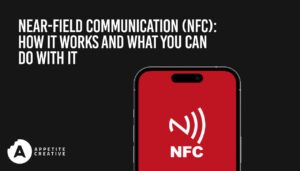Introduction
Near-Field Communication, or NFC for short, is a technology that allows devices to communicate with each other when they’re close together. NFC makes life more convenient and efficient in many ways, enabling a world of possibilities from contactless payments to smart home automation. But how exactly does it work, and what can you do with it? Read on to find out.
To learn more about this, please see What is NFC and what is it used for?
Understanding NFC
At its core, NFC is a set of communication protocols that allows two electronic devices to establish communication when they’re within a range of approximately 4 centimetres (1.6 inches). It’s a type of radio-frequency identification (RFID), but it’s designed for use over much shorter distances.
When two NFC-enabled devices are brought close together, they communicate via electromagnetic radio fields. One device acts as the initiator, generating a radio frequency field that can power a passive target (like an NFC tag). This leads to an exchange of data between the two devices.
How NFC Works
Let’s break it down a bit further. NFC works using two types of components: an initiator and a target. The initiator generates a low-power radio frequency field, and the target receives this field and responds to it. The interaction can be either one-way (like reading an NFC tag) or two-way (like two smartphones exchanging data).
Moreover, NFC is unique in its ability to have one of the devices be unpowered, like an NFC tag. This tag, when brought into the NFC field created by a powered device (like a smartphone), will derive its power from that field. This makes it incredibly energy-efficient and cost-effective for a wide range of applications.
What You Can Do With NFC
The applications of NFC are broad and varied. Here are some of the most common uses:
1. Contactless Payments: NFC technology is the backbone of contactless payment systems like Apple Pay, Google Pay, and Samsung Pay. You simply need to bring your smartphone close to the payment terminal, and the payment information is transferred securely and quickly.
2. Smart Home Automation: NFC tags can be used to trigger a series of actions on your smartphone, making your home smarter. For example, you can have an NFC tag near your front door that turns on your home’s lights and heating when you tap your phone to it.
3. Data Sharing: NFC makes sharing data between devices effortless. This could be anything from contact information to photos and links. Just bring the two NFC-enabled devices close, and the data can be transferred.
4. Public Transport: Many public transportation systems around the world use NFC technology for their ticketing systems. Just tap your card or phone on the reader, and you’re good to go.
Connected Packaging and NFC
One of the exciting and emerging applications of NFC technology is in the field of Connected Packaging. NFC tags embedded in product packaging can provide consumers with a wealth of information and interactive experiences.
For instance, by scanning an NFC-enabled wine bottle, consumers could access details about the vineyard, the grape variety, and suggested food pairings. Similarly, cosmetic companies can provide information about product usage, ingredients, and tutorials. It can also be a tool for brand authentication and anti-counterfeiting efforts, offering consumers the peace of mind that they’re purchasing a genuine product.
As of 2021, Statista reported that the global market for smart packaging, including NFC-enabled Connected Packaging, is projected to reach over $8 billion by 2025, signifying the growing trend towards making packaging more interactive and informative through technologies like NFC.
Impact and Statistics of NFC
The impact of NFC is reflected in the impressive numbers it has recorded. According to a report by Grand View Research, the global NFC market size was valued at $10.21 billion in 2020 and is expected to expand at a compound annual growth rate (CAGR) of 13.8% from 2021 to 2028.
Contactless Payments: For example, in the United States alone, Apple Pay, a prominent NFC payment platform, had an estimated 507 million users globally in 2021. This shows the rising popularity of contactless payments enabled by NFC.
Public Transport: NFC technology has been widely adopted in public transportation systems worldwide. For example, in London, around 53% of all pay-as-you-go journeys are made using contactless payment methods, largely enabled by NFC, as of 2021.
Conclusion
In summary, NFC technology has opened up a myriad of opportunities for making our daily lives easier and more convenient. Whether it’s making a quick contactless payment at the supermarket, sharing photos with a friend, or turning on your home’s heating system with a simple tap of your phone, NFC has indeed revolutionised how we interact with the world around us. As the technology continues to evolve, we can expect even more innovative uses for NFC in the future.

Visit Appetite Creative’s Blog for more of such content!
